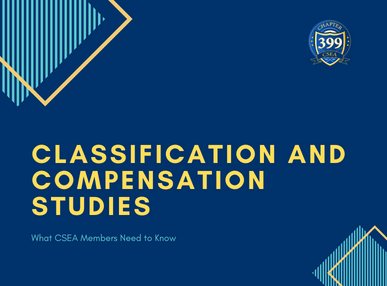Ensuring that every CSEA member understands the inner workings of important processes affecting our jobs and livelihoods. No single process that affects the members of the CSEA 399 community should ever be overlooked. This article has been written to help you understand and by trying to answer the basic questions about the Classification and Compensation Study. So, let’s dive into what this study entails and why it matters to everyone.
Understanding Classification and Compensation Studies
At its core, a classification and compensation study is a comprehensive analysis conducted by organizations to evaluate and establish the structure of job classifications and corresponding compensation levels within the workplace. But what does that mean for us as union members?
Job Classification: Putting Everyone in Their Place
Imagine our workplace as a puzzle, with each position representing a unique puzzle piece. A classification study helps ensure that each piece fits into the puzzle correctly. It begins by examining all the positions within the organization to determine their duties, responsibilities, required skills, and qualifications. Jobs with similar duties and responsibilities are grouped into job classifications or families.
Job Evaluation: Assessing the Worth of Each Piece
Once the jobs are classified, they are evaluated based on various factors such as required education, experience, complexity, decision-making authority, and level of responsibility. This evaluation helps determine the relative worth or value of each job within the organization. Think of it as assigning a point system to each puzzle piece based on its size, shape, and intricacy.
Compensation Analysis: Ensuring Fairness and Equity
Now comes the crucial part – compensation analysis. This involves reviewing current salary and benefits data, benchmarking against industry standards, and ensuring internal equity among similar job classifications. The goal is to ensure that everyone is fairly compensated for the value they bring to the organization. No one wants to feel like they’re getting the short end of the stick, and a proper compensation study helps prevent just that.

Why It Matters to You
You might be wondering why all of this matters to you as a union member. Well, let me break it down for you with a list of the pros and cons of the Classification and Compensation Studies:
Pros of Classification and Compensation Studies:
- Fair Pay: A classification and compensation study ensures that your pay is fair and reflects your work. It helps prevent disparities in pay based on factors like gender, race, or personal connections.
- Transparency: By clearly defining job classifications and responsibilities, these studies can help protect your job from being arbitrarily changed or eliminated.
- Career Growth: Understanding how your position is classified and evaluated can provide insight into potential career advancement opportunities within the organization.
- Union Advocacy: Armed with the findings of these studies, our union can better advocate for fair wages, benefits, and working conditions on behalf of all members.
- Retention and Recruitment: Fair compensation structures make the organization more attractive to both current employees and potential recruits, helping to retain talent and attract new skilled workers.
- Legal Compliance: Classification and compensation studies help organizations comply with labor laws and regulations regarding fair pay practices, reducing the risk of legal disputes and penalties.
Cons of Classification and Compensation Studies:
- Time and Resources: Conducting comprehensive studies can be time-consuming and resource-intensive, requiring dedicated staff and financial investment.
- Resistance to Change: Employees may resist changes to job classifications or compensation structures, especially if they perceive that it could negatively impact their pay or status within the organization.
- Complexity: The process of evaluating job classifications and compensation levels can be complex, requiring specialized knowledge and expertise in human resources and compensation management.
- Subjectivity: Despite efforts to create objective evaluation criteria, there may still be subjective elements involved in determining job worth and compensation levels, leading to potential disagreements or perceptions of bias.
- Potential for Disruption: Implementing changes based on the findings of classification and compensation studies can disrupt the organization’s operations and may require adjustments to policies, procedures, and employee contracts.
In Conclusion
Classification and compensation studies may seem like complex processes, but they’re crucial for ensuring fairness, equity, and transparency in the workplace. Home this article helps to demystify these processes and ensure that every one of you has the information you need to advocate for your rights and interests in the workplace. After all, knowledge is power, and together, we can build a stronger, more equitable workplace for all.

